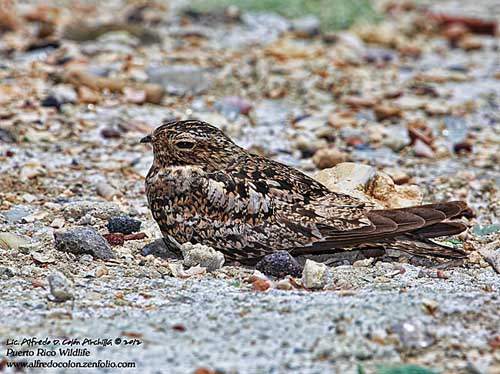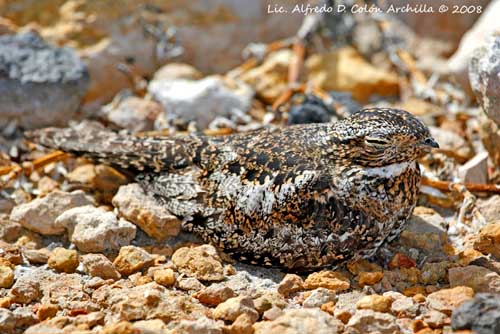
Fr: Engoulevent piramidig
All: Antillennachtschwalbe
Esp: Añapero Querequeté
Ital: Caprimulgo-sparviero delle Antille
Nd: Antilliaanse Nachtzwaluw
Sd: Karibisk falknattskärra
Photographer:
Alfredo Colón
Puerto Rico Wildlife
Text by Nicole Bouglouan
Sources:
HANDBOOK OF THE BIRDS OF THE WORLD Vol 5 by Josep del Hoyo-Andrew Elliott-Jordi Sargatal - Lynx Edicions - ISBN: 8487334253
A GUIDE TO THE BIRDS OF MEXICO AND NORTHERN CENTRAL AMERICA by Steve N. G. Howell, Sophie Webb - Oxford University Press - ISBN: 0198540124
BirdLife International (BirdLife International)
The Cornell Lab of Ornithology – Neotropical birds
Wikipedia, the free encyclopaedia
Antillean Nighthawk
Chordeiles gundlachii
Caprimulgiforme Order – Caprimulgidae Family
BIOMETRICS:
L : 20-21 cm
DESCRIPTION:
The Antillean Nighthawk belongs to the subfamily « Chordeilinae » which includes the partially diurnal nighthawks. Formerly regarded as the Caribbean form of the Common Nighthawk (Chordeiles minor), it is now considered a distinct species by its different call and song, and its sympatric breeding on Florida Keys.
This species occurs in two morphs, greyish and tawny.
The adult male has brown to blackish-brown upperparts with heavy greyish-white, buff and cinnamon spotting. The nape is brown with pale spots, but there is not nuchal collar. The upperwing-coverts are brown with variable spotting, from greyish-white or pale buff to cinnamon. The flight feathers are dark brown. The wings are pointed and show a white wing patch conspicuous in flight. The tail is brown with several dark bars and a broad white subterminal band well visible in flight.
On the underparts, the male shows a white throat patch. The underparts are brown with greyish-white barring. Belly and flanks are buffish barred brown.
On the head, the crown is dark brown with pale buff spotting. There is a greyish-white supercilium.
The bill is blackish. The eyes are dark brown. Legs and feet are brownish.

The female is slightly different. She has buffish throat patch, not white. She has less conspicuous white wing patches, and she lacks the white subterminal bar on tail.
The juvenile is duller with short tail.
The immature resembles adults, but it has heavily barred underparts, the throat patch is duller and spotted, primary and secondary flight feathers are narrowly tipped white and it lacks the white patch on tail.
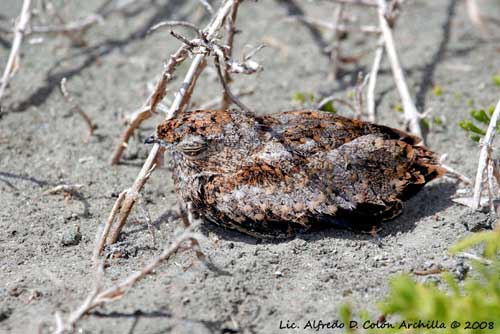
We can find two subspecies:
C.g. vicinus is found in S Florida and Bahamas. This one appears smaller than nominate race, and it occurs only in greyish morph.
C.g. gundlachii (here described and displayed) is found in Cuba and Island of Pines, Cayman Is, Jamaica, Hispaniola, Puerto Rico and Virgin Is.
VOICE: SOUNDS BY XENO-CANTO
The Antillean Nighthawk male gives repeated “chitty-chit” or “killy-kadick” during territorial and courtship display flights. We can also hear a nasal “penk-dik”.
While singing, the white throat patch is displayed and puffed out at each call. At closer range, this is a visual signal to rivals and potential mates.
Usually silent, it becomes more vocal at the beginning of the breeding season.
HABITAT:
The Antillean Nighthawk usually frequents open and semi-open arid country where they can nest on the ground. It also may occur in recently cleared areas, in cane fields and pastures.
RANGE:
See above in “subspecies”.
BEHAVIOUR:
The Antillean Nighthawk is an insect-eater, feeding on moths, beetles and various other insect species. It may hunt alone or in pairs, or in small flocks too. According to the weather, it may forage by day, on warm, cloudy days and after rain.
It hunts in flight, foraging over forests, fields, pastures, shorelines and towns, mainly at dusk and dawn. Thanks to its agile flight, it is able to pursue the preys. The wide gape allows it to hawk insects, but it also just snaps at them when they come close to its bill.
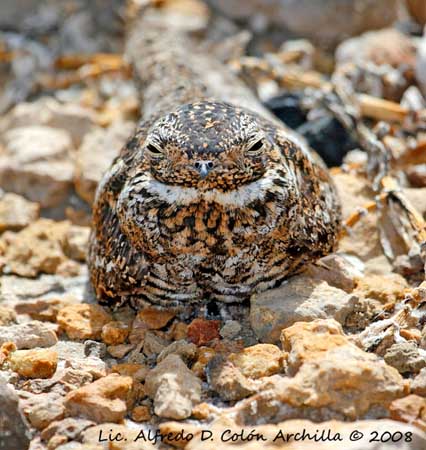
At the beginning of the breeding season, the Antillean Nighthawk male performs territorial and courtship displays. They are monogamous and usually pair for life, or at least for one season.
The territory is established by the male and strongly defended against rivals. The male sings loudly towards a neighbour male. Some fights may occur but usually, they adopt aggressive posture and sing.
The male performs aerial courtship displays, circling highly up and then, diving with the wings held in V-shape above the back, showing conspicuously the white wing patches.
When it comes out of the dive, it bends suddenly the wings downwards while producing a “booming” sound.
The Antillean Nighthawk is highly migratory and leaves the breeding grounds by August-September, and returns in April.
The wintering areas are unknown, but thought to be in South America.
FLIGHT:
The Antillean Nighthawk performs erratic and swift flight. When hunting, the agile flight allows the bird to make sudden twists, turns, wheels, rises and dives while pursuing a flying insect.
REPRODUCTION:
The breeding season varies according to the range, but usually occurs between mid-April and mid-August throughout the range.
The Antillean Nighthawk may occasionally nest in loose colonies with the Common Nighthawk. The nest is on the ground, on gravel or sand, in open patch among pebbles or small stones, sometimes in cavity in some coral rock.
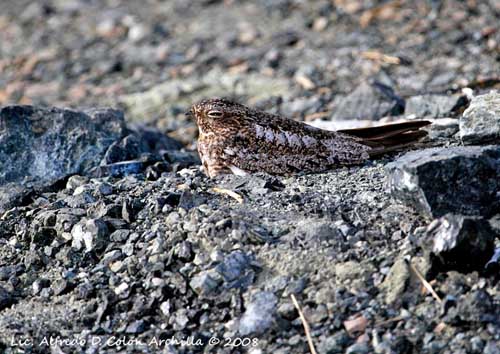
The female lays 1-2 eggs on the ground. These eggs have cryptic colours and bend in with the pebbles and the sand. She incubates during 19 days. At hatching, the semi-precocial chicks are covered in cryptic-coloured down. They move around the nest-site under the protection of adults. They are fed by regurgitation of balls of insects directly into their mouths, or they take the food into the parents’ mouths.
If threatened, the chicks adopt the typical flattened posture and remain motionless on the ground with eyes shut, while adults perform distraction displays.
DIET:
The Antillean Nighthawk is an insect-eater, feeding on various insect species, and especially moths and beetles.
PROTECTION / THREATS / STATUS:
The Antillean Nighthawk is usually locally common throughout most of the breeding range.
The race “vicinus” seems to have slight range expansion due to habitat loss and human developments in Florida Keys.
The Antillean Nighthawk is not currently threatened.
